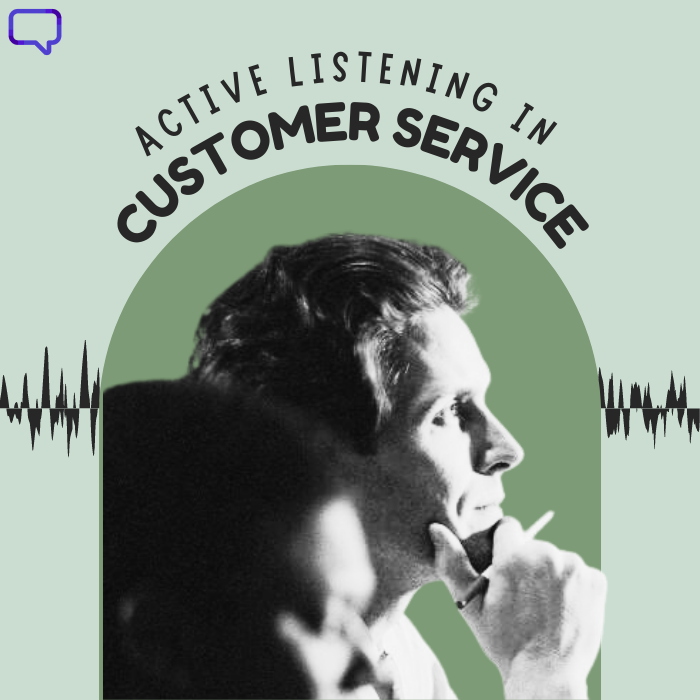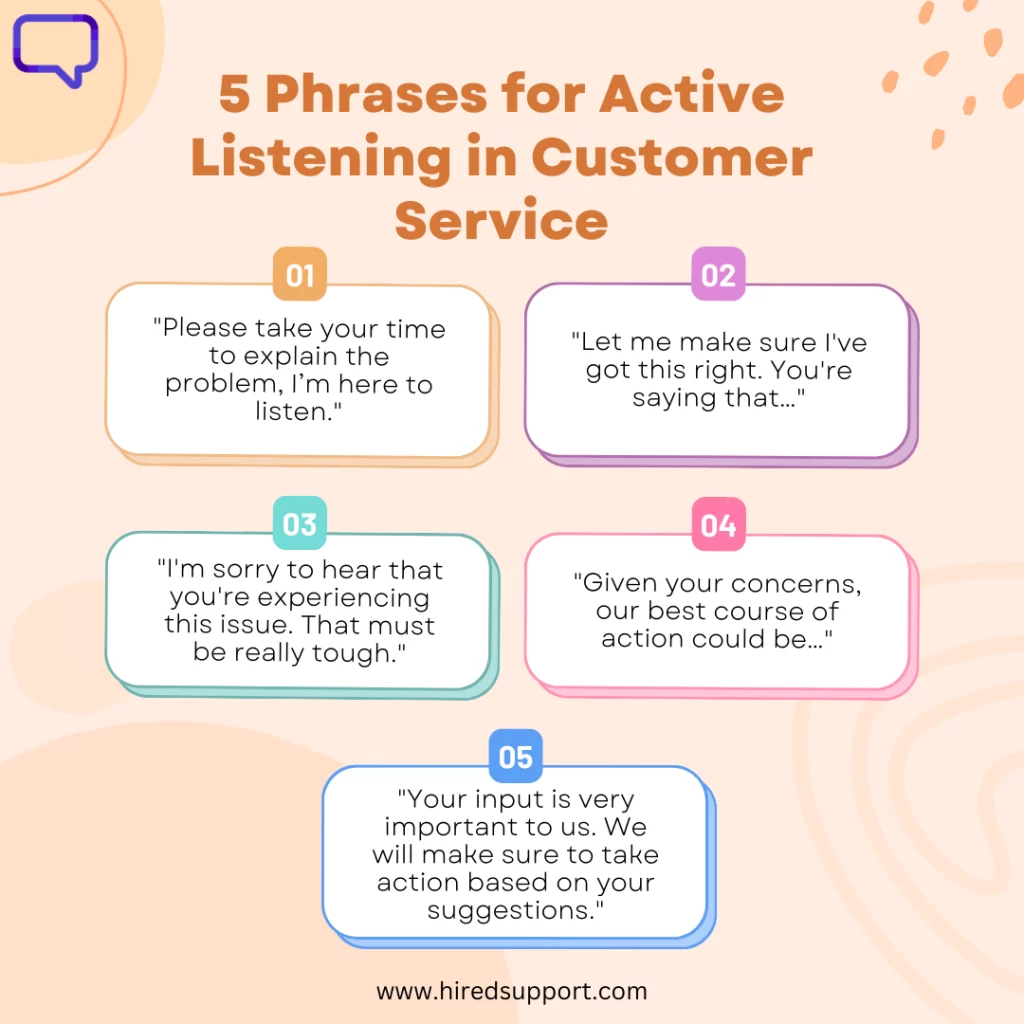There’s a striking difference between hearing and listening. Hearing is simply the noise we hear during our daily life, the one our brain tunes out and ignores. It requires no effort, is involuntary, and is accidental. On the contrary, listening requires effort. It is voluntary, focused, and intentional. That’s why good listeners are revered, even if nobody listens to them in return. Imagine, then, someone who’s not only a good listener, but an active one as well, especially in a field such as customer service! Active listening in customer service is an essential skill. Keep reading to find out why!
Table of Contents
Key Takeaways
- Active listening in customer service means fully focusing on what a customer is saying. It requires a proper understanding of the query, responding in an empathic tone, and then remembering what they said.
- By listening actively to customers, their concerns can be accurately understood and resolved. This results in increased customer satisfaction and loyalty.
- To better understand how a customer feels, it’s important to pay attention to their tone of voice and pace. This can be helpful when trying to solve problems and increase customer satisfaction.
- By actively listening to customers and taking their feedback into consideration, customer service can improve. The implementation of feedback shows customers that their input is valued and can lead to better service in the future.
What is Active Listening in Customer Service
Active listening customer service is an essential customer service skill that plays a vital role in effective communication with customers and in improving customer satisfaction.
It is more than just hearing words; it’s about understanding the complete message that a person is trying to convey.
In customer service, it’s the key to making your customers feel valued and understood.
Furthermore, active listening reduces misunderstandings by 40%!
7 Key Principles of Active Listening in Customer Service
Attentiveness
Be present in the conversation. The first principle of active listening in customer service involves being entirely present during customer interaction.
By focusing on the customer’s words, you not only show respect but also foster a genuine connection.
Demonstrating attentiveness can create a positive customer experience, leading to increased customer loyalty.
Patience
Allow the customer to speak uninterrupted. Patience, often under-emphasized in customer service skills training, is vital.
It involves allowing the customer to express themselves without interruption.
This practice often results in richer customer feedback and enables more effective problem-solving by fully understanding the issue at hand.
Clarification
Confirm your understanding. One of the most important aspects of effective communication in customer service is ensuring that you’ve correctly understood the customer’s needs or concerns.
Active listening encourages us to seek clarification through summarizing or paraphrasing, ensuring both parties are on the same page.
Empathy
Validate the customer’s feelings. Empathy in customer service involves acknowledging and validating the customer’s feelings.
Empathetic responses show customers that their emotions are recognized and valued, which can greatly enhance the customer experience and improve customer retention.
Non-Verbal Cues
Pay attention to the unspoken. Active listening isn’t just about the words spoken; it’s also about the unspoken cues.
Non-verbal communication like tone of voice or body language can offer valuable insights into the customer’s feelings and can help in more effective problem-solving.
Response
Provide relevant and thoughtful feedback. Active listening in customer service is characterized by providing thoughtful and relevant feedback.
This not only validates that you were listening but also assures the customer that their concerns are being addressed.
Timely responses can go a long way in service recovery and improving customer satisfaction.
Action
Implement the feedback. Finally, active listening involves taking the feedback received and implementing it.
When customers see their feedback being taken seriously and acted upon, it fosters customer loyalty and aids in your overall customer service strategies.
The Importance of Active Listening in Customer Service
Active listening in customer service is the magic ingredient that can enhance a customer’s experience with your company.
It plays a significant role in problem-solving and understanding the customer’s needs accurately. This boosts customer satisfaction and loyalty, which are the ultimate goals of any business.
How Does Active Listening Work in Customer Service
Imagine you’re a customer service agent.
A customer approaches you with a problem. You don’t just hear the issue; you listen actively.
You pay full attention to the customer, you empathize with them, and you make sure you understand their issue before you propose a solution. That’s active listening in a nutshell.
Steps to Active Listening in Customer Service
Pay Full Attention
Don’t just hear; listen. Block out distractions and focus on the customer’s words.
Show You’re Listening
Use verbal cues like ‘I see’ or ‘go on’ to encourage the customer to continue.
Clarify the Issue
Paraphrase what the customer has said to ensure you’ve understood correctly.
Empathize
Show the customer that you understand and validate their feelings.
Respond Thoughtfully
Once you’ve understood the issue, provide a thoughtful, relevant response.
5 Steps to Active Listening
To encourage active listening in customer service, keep in mind the following phrases and follow them step-by-step:
Full Attention and Encouragement Cues
“I’m here to help you. Can you tell me more about the issue?”
“I understand that this is important to you. Please go on.”
“Please take your time to explain the problem, I’m here to listen.”
Issue Clarification
“So, if I understand correctly, the main problem is…”
“Let me make sure I’ve got this right. You’re saying that…”
Empathy
“I understand how frustrating this situation must be for you.”
“I’m sorry to hear that you’re experiencing this issue. That must be really tough.”
“I can imagine how upsetting this must be. Let’s see what we can do to resolve it.”
Thoughtful Response
“Based on what you’ve told me, I suggest we try…”
“Given your concerns, our best course of action could be…”
Feedback Implementation
“Thank you for bringing this issue to our attention. We value your feedback and will take the necessary steps to address it.”
“Your input is very important to us. We will make sure to take action based on your suggestions.”
Conclusion
Mastering the art of active listening in customer service isn’t just a skill – it’s a mindset.
Think of companies like Zappos that have set the gold standard in treating customers as more than just transactions.
Their success isn’t just about solving problems but about how they make customers feel heard and valued.
By practicing active listening, we don’t just improve our services but also build lasting relationships with our customers.
In the world of customer service, there’s perhaps no greater achievement than a customer who feels truly understood.
So, let’s tune in, pay attention, and pave the way for unparalleled customer satisfaction.
FAQs
The three components of active listening are paying attention, reflecting and paraphrasing, and asking questions.
Unlike passive hearing, active listening involves processing information, providing feedback, and fully engaging in the communication process.
It’s an active participation in the conversation, ensuring the speaker feels genuinely heard and understood.




